Key takeaways:
- Racial disparities significantly influence access to advocacy resources and reproductive health, highlighting the need for inclusive dialogues.
- Effective pro-life advocacy involves not only protecting the unborn but also addressing systemic issues that impact families, especially in marginalized communities.
- Empathy and understanding are crucial in bridging gaps within the movement, as miscommunication can hinder progress towards equity.
- Building trust through genuine relationships and tailored outreach can enhance community engagement and foster a more inclusive pro-life movement.
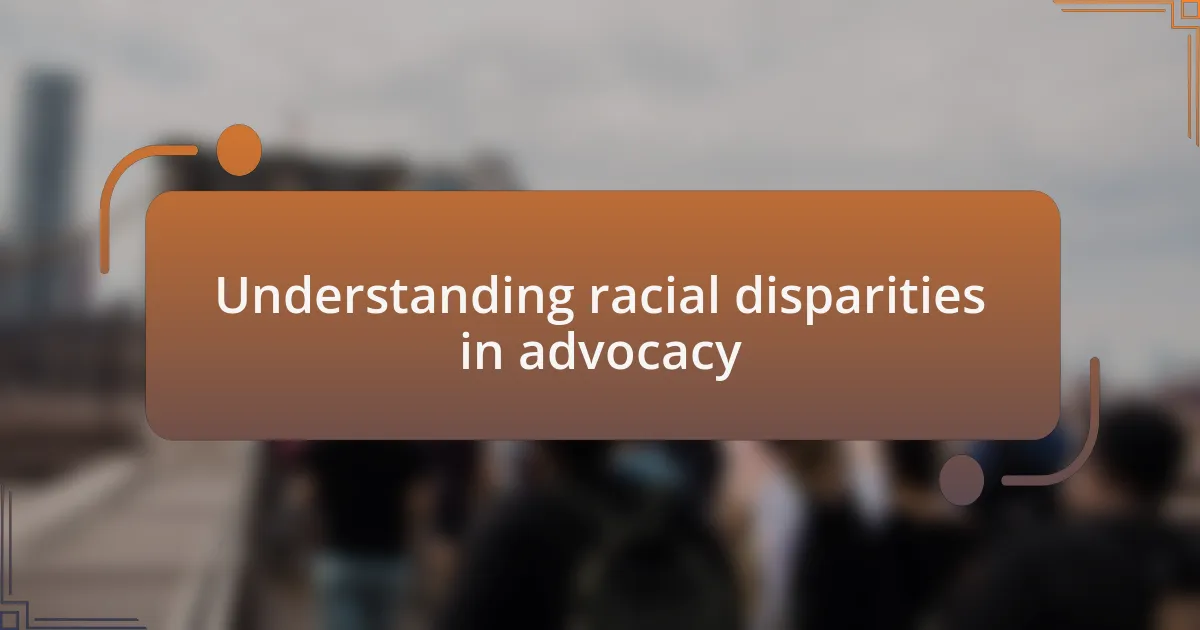
Understanding racial disparities in advocacy
As I delved deeper into understanding racial disparities in advocacy, I realized how often our conversations about life issues overlook the unique struggles faced by different communities. For instance, I vividly remember attending a pro-life rally where a friend shared her experience of feeling marginalized, not because of her stance on life, but due to her racial identity. It struck me—how many voices are unheard simply because we fail to see the intersection of race and advocacy?
In my journey, I often ponder: how can we truly advocate for all lives when some are more visible than others? The reality is that racial disparities shape access to resources, education, and even healthcare, which are all central to pro-life advocacy. This realization compelled me to ask questions, not just about policies, but about the individuals behind them.
Connecting with advocates from various backgrounds opened my eyes to the importance of inclusive dialogues. I recall an enlightening conversation with an advocate who passionately shared her perspective on how racial inequality complicates reproductive health access in her community. This dialogue fueled my understanding that true advocacy must address these disparities head-on, fostering an environment where every voice is not just heard but valued.
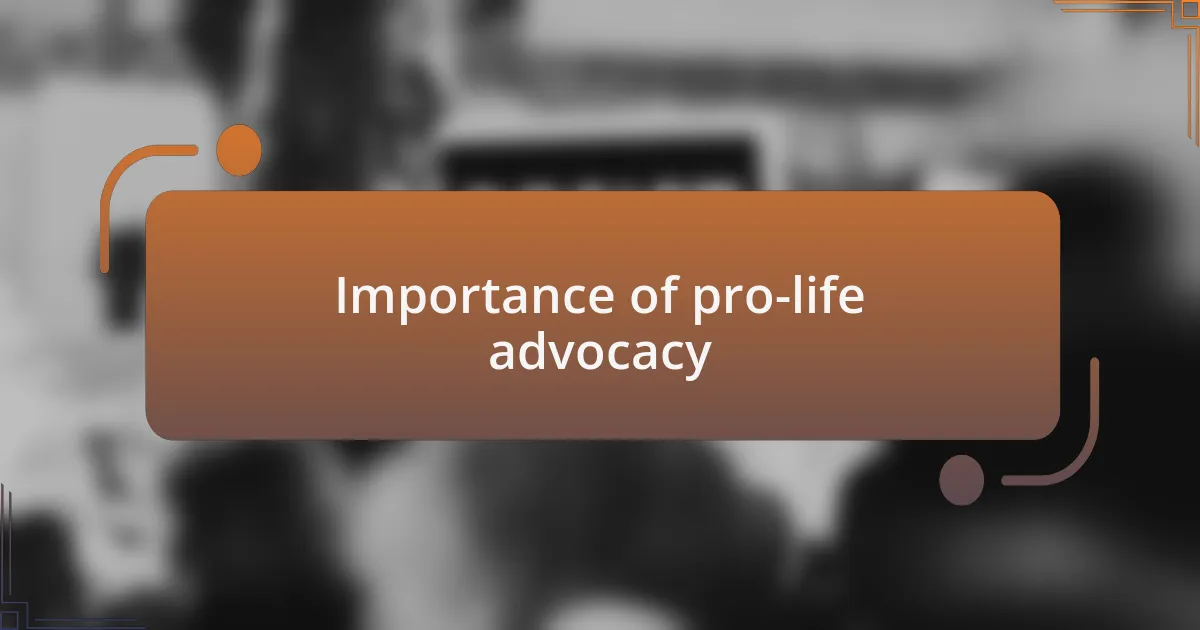
Importance of pro-life advocacy
Pro-life advocacy is essential because it positions the sanctity of life at the forefront of societal discussions. I remember a poignant moment at a community meeting where a local mother shared her struggle to find support during her pregnancy. Her story highlighted the urgent need for initiatives that not only protect life but also nurture it, especially in vulnerable communities.
Moreover, understanding the importance of pro-life advocacy means recognizing that many lives are intricately intertwined with systemic issues. I often think about how effective our advocacy can be if we address not only the need to protect the unborn but also to enhance the quality of life for families facing socioeconomic challenges. Have we considered how our efforts can extend beyond legislation to create lasting change in these communities?
Finally, engaging in pro-life advocacy fosters a sense of solidarity and compassion. During a recent workshop, I was moved by the testimonials from individuals who had overcome immense obstacles. Each story served as a reminder that our mission goes beyond simply championing life; it’s about standing with those who need it most and amplifying voices that have been historically silenced. This shared purpose can inspire more people to join the cause, ultimately enriching the movement.
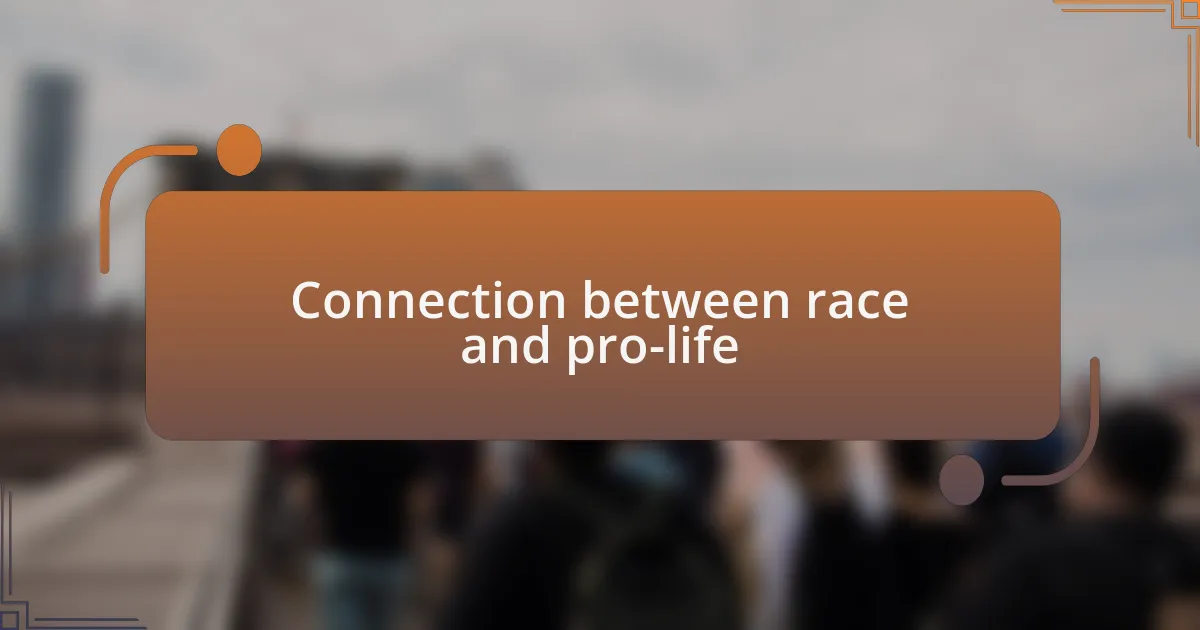
Connection between race and pro-life
Many people may not realize that racial disparities significantly influence perspectives within the pro-life movement. I recall attending a seminar where we discussed how marginalized communities often face higher rates of abortion, influenced by factors like access to healthcare, education, and economic stability. It made me wonder: how can we truly advocate for life if we don’t first consider the lived realities of these individuals?
In my conversations with friends and fellow advocates, I’ve learned that race can shape how individuals engage with pro-life issues. I remember speaking with a woman who expressed that her experience in a predominantly minority neighborhood often left her feeling unheard and unsupported in her pro-life beliefs. This realization reminds me that bridging the gap requires not just advocacy but listening and understanding the unique challenges faced by different communities.
Moreover, I’ve seen firsthand how initiatives tailored to diverse populations can empower individuals to embrace pro-life values more fully. At a recent event, we highlighted stories from women of various backgrounds who chose life despite immense pressures. Hearing their triumphs brought to light an essential truth: when we center the conversation around race and its impact, we honor those stories and expand our movement to be truly inclusive.
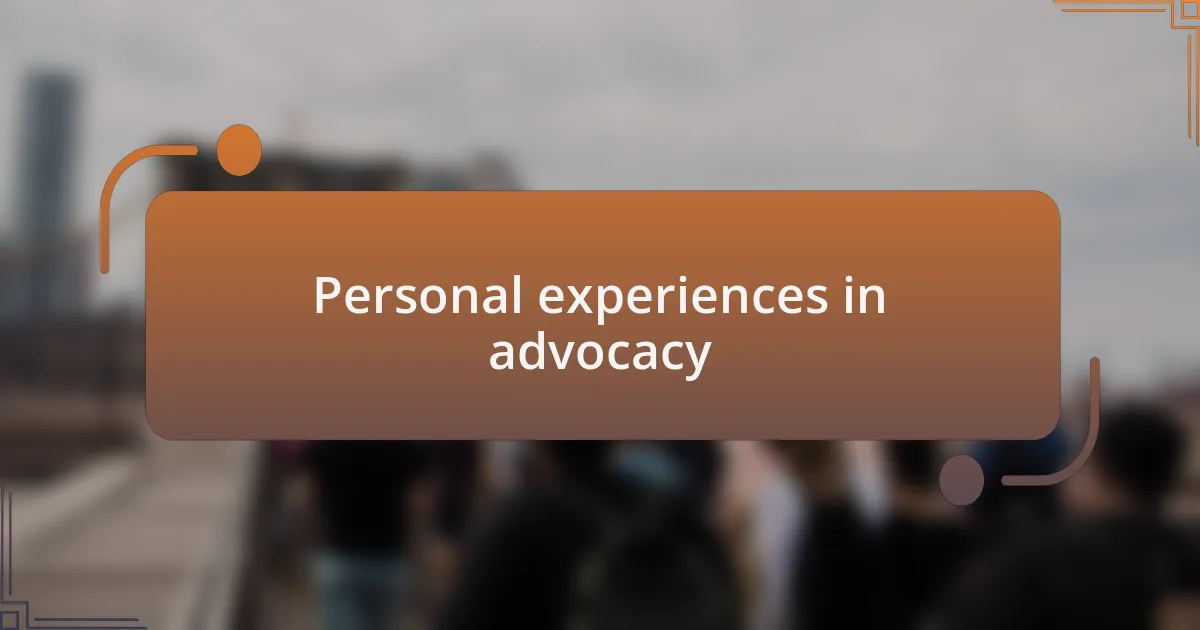
Personal experiences in advocacy
When I first dove into pro-life advocacy, I was struck by how deeply personal the stories were. One memory stands out: I volunteered at a local clinic in a diverse neighborhood, where I listened to a young mother share her dilemma about an unplanned pregnancy. Her vulnerability opened my eyes to the weight of societal pressures and economic barriers that often influence decisions about life. It made me question, how can we claim to support life without truly understanding the fears and hopes that accompany these choices?
At another gathering, I found myself in a discussion group with advocates from different racial backgrounds discussing our motivations. One of them shared a heart-wrenching story about her own abortion experience, shaped by a lack of resources in her community. As she spoke, I felt the tension between her pain and the larger narrative of the pro-life movement. It was a powerful reminder that our advocacy must include these voices to create real change.
Reflecting on these interactions, I realize that advocacy is not just about numbers or policies; it’s about the individual stories that shape our understanding of life. There’s a profound responsibility we carry to uplift diverse voices within this movement. How often do we step back to listen instead of speak? I think we can do better by fostering spaces where these discussions can happen, ensuring our advocacy is as rich and varied as the lives we seek to support.
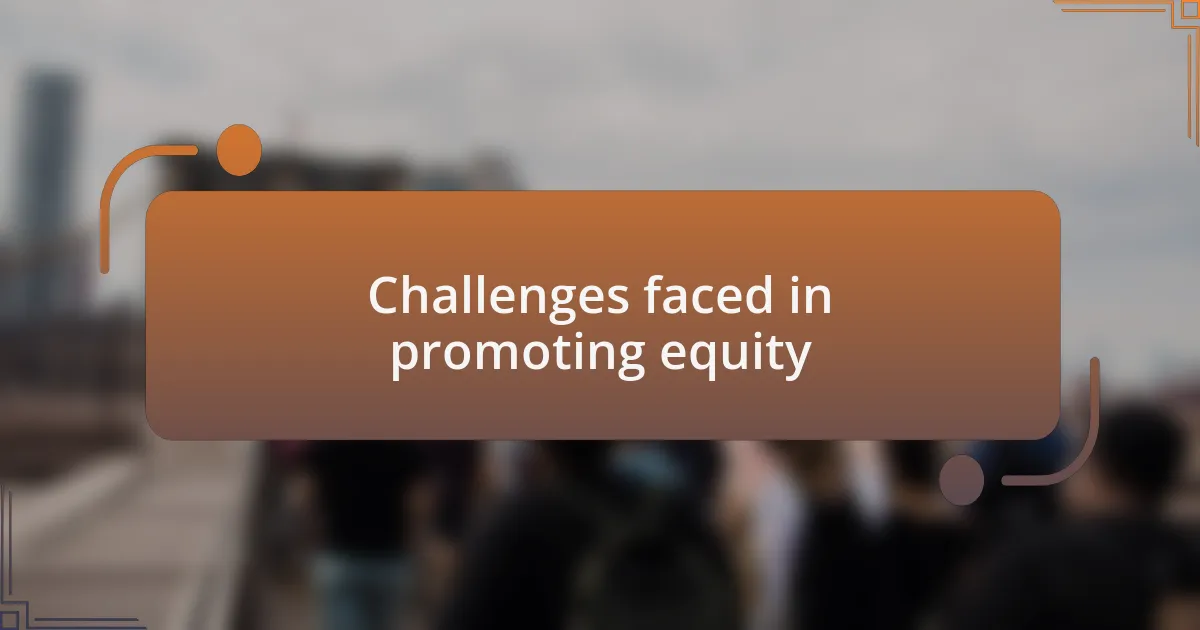
Challenges faced in promoting equity
Promoting equity in pro-life advocacy is fraught with challenges. During a recent outreach event, I witnessed firsthand the disconnect between our mission and the realities faced by marginalized communities. A passionate volunteer from a lower-income neighborhood pointed out how our messaging often misses the mark, failing to resonate with those living in fear of financial instability and inadequate healthcare. How can we truly advocate for life if we are blind to the struggles specific to varied communities?
I’ve also felt the weight of miscommunication and misunderstandings among advocates. In one meeting, an attempt to address racial disparities led to defensiveness from some in attendance. It was a stark reminder that even within our movement, equity discussions can fracture relationships instead of fostering understanding. Can we really bridge these gaps if we don’t approach these conversations with empathy and a willingness to learn?
Additionally, there is the challenge of navigating differing perspectives. I remember more than once when discussing racial equity brought up discomfort rather than engagement. I realized that for many, acknowledging these disparities feels like an acknowledgment of failure, rather than an opportunity for growth. What if we embraced these dialogues as a chance to cultivate a more inclusive movement, rather than seeing them as a threat to our mission?
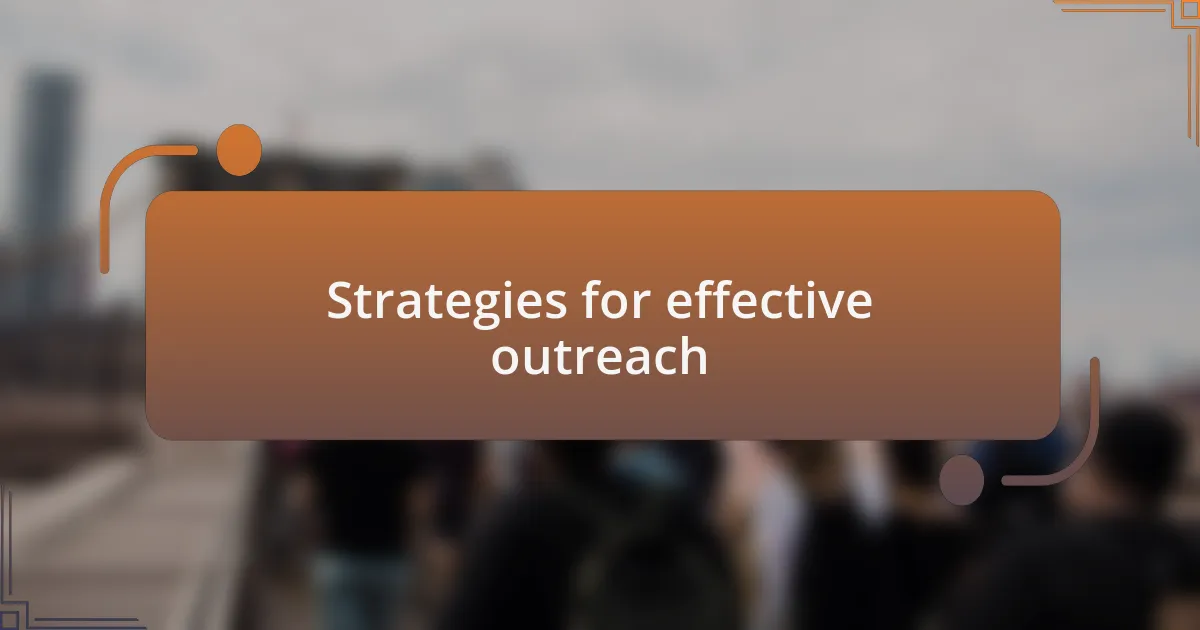
Strategies for effective outreach
When it comes to effective outreach, I’ve found that establishing genuine relationships within the community can make all the difference. At a local health fair, I connected with several families who expressed skepticism about our intentions. It was then I realized that trust isn’t given; it’s earned through consistent engagement and empathy. How can we make a lasting impact if we only show up when we want to share our message?
One impactful strategy I’ve employed is to tailor our outreach materials to reflect the cultural and socioeconomic realities of the communities we aim to serve. During a recent volunteering experience, we created pamphlets that utilized language and imagery resonating with families who often feel sidelined. I watched as people’s eyes lit up when they saw familiar faces in our materials, sparking conversations that wouldn’t have happened otherwise. Isn’t it fascinating how small changes can lead to deeper connections?
Lastly, I encourage the use of storytelling as a powerful outreach tool. I remember a young mother sharing her journey—all the hurdles she faced while navigating healthcare as a person of color. Her story not only touched everyone present but also served as a poignant reminder of why our mission matters. Can we afford to overlook these narratives when they hold the key to understanding the urgency of our advocacy? Engaging with real stories can inspire change and foster a sense of shared purpose.
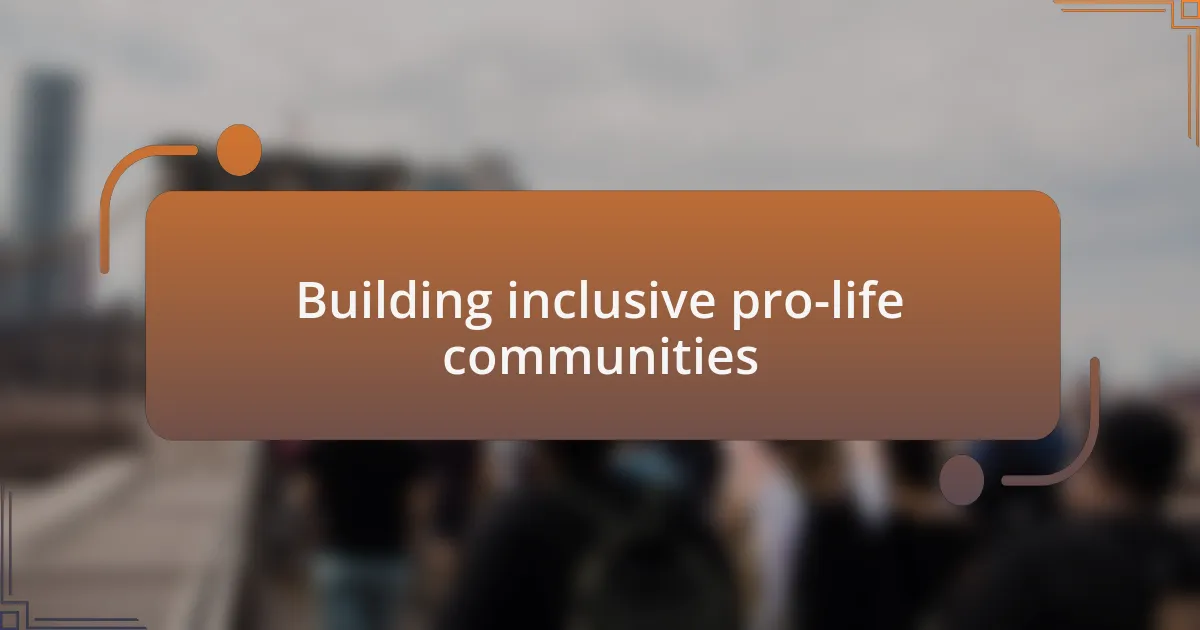
Building inclusive pro-life communities
Building inclusive pro-life communities starts with listening to the unique stories and struggles faced by individuals from diverse backgrounds. I remember organizing a community meeting where we invited voices from various racial and socioeconomic groups. The discussions were eye-opening; hearing about their experiences with healthcare and family planning informed our approach significantly. How can we champion a cause if we don’t first understand the people it impacts the most?
It’s crucial to create safe spaces where individuals feel seen and heard. In one initiative, we hosted a gathering specifically for women of color, allowing them to share their thoughts and experiences within the pro-life movement. The honesty in their narrative emphasized the importance of intersectionality in advocacy. Are we doing enough to ensure that every voice is valued, or are we allowing certain stories to drown in the noise?
Furthermore, actively seeking partnerships with local organizations that already serve marginalized communities can amplify our efforts. I recall collaborating with a local women’s shelter where we tailored our resources to meet their needs. This partnership not only expanded our outreach but also fostered genuine relationships rooted in mutual respect. Isn’t it time we broaden our base to ensure our community reflects the diversity of those we aim to serve?